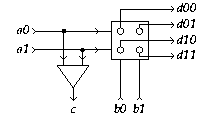EDIS:
Guide |
FAQ |
New |
Search |
Bibliography |
Index |
Feedback
Decision Call
Informal
A (non-arbitrating, blocking) Decision Call has
four input terminals (a0, a1, b0, b1) and
five output terminals
(c, d00, d01, d10, d11).
A signal appearing on either of the a_i terminals will cause
a signal to be produced at terminal c.
The combination of a signal at terminal a_i and
terminal b_j will cause a signal to be produced at
terminal d_i_j.
It does not matter which of the two input signals arrives first.
The environment of a Decision Call
must guarantee mutual exclusion of
the signals on a0 and a1, and also on b0 and b1.
The a_i and c signals alternate,
the a_i and d_i_j signals alternate, and
the b_j and d_i_j signals alternate.
Schematic diagram
for a Decision Call:

[Zoom|FIG]
XDI state graph
for a Decision Call:(to be editted)

[Zoom|FIG]
Specification in XDI model.
Specification in Verdect:
define DCALL( a0?, d00!, d01!, a1?, d10!, d11!, c!, b0?, b1? ) =
pref *[ (a0? | a1?); c! ]
|| pref *[ (a0? || b0?); d00!
| (a0? || b1?); d01!
| (a1? || b0?); d10!
| (a1? || b1?); d11!
]
end
Also available through this link
Specification in DI Algebra.
An alternative specification, making use of so-called alternations,
is also given:
Specification in DI Algebra:
NAME = "Decision-Call"
I = { a0?, a1?, b0?, b1? }
O = { c!, d00!, d01!, d10!, d11! }
D = [ a0? -> c!;[b0? -> d00!;D, b1? -> d01!;D]
, a1? -> c!;[b0? -> d10!;D, b1? -> d11!;D]
]
[{a0,a1},{c}]
[{a0,a1},{d00,d01,d10,d11}]
[{b0,b1},{d00,d01,d10,d11}]
Also available through this link.
This
comparison shows
that the two specifications are equivalent.
XDI Report.
The roles of subscripts 0 and 1 can be interchanged,
independently on both a and b,
provided that the d outputs are permuted accordingly:
...
In [Dickson74, p. 46],
a Decision Call is referred to as `CALL Element'.
The informal specification there says:
- A signal appearing at any one of the initiation terminals
[a_i in our description]
will cause a signal to be produced at the DO terminal
[c in our description].
- The combination of a signal at one of the initiation terminals
(Im) [a_i in our description]
and a signal at one of the return terminals (Rn)
[b_j in our description]
will cause a signal to be produced at the completion terminal
corresponding to the combination (Cmn)
[d_i_j in our description].
It does not matter which of the two incoming signals arrives first.
Note the last sentence, which specifically distinguishes the
Decision Call from
the nr-data-demux,
which requires that the environment refrains from inputting on any b_j
until output c has been produced.
It is, however, not clear from the description
in [Dickson74, p. 46]
when `new' input signals can be offered.
In particular, it is not clear whether a new input signal on b_j
must await the `preceding' output signal c.
References
[Dickson74, p. 46]
[Ornstein67, p. 348]
Last modified at Fri Nov 20 10:11:39 1998
Encyclopaedia of Delay-Insensitive Systems
Copyright © 1995-1998
Tom Verhoeff /
Tom.Verhoeff@acm.org


